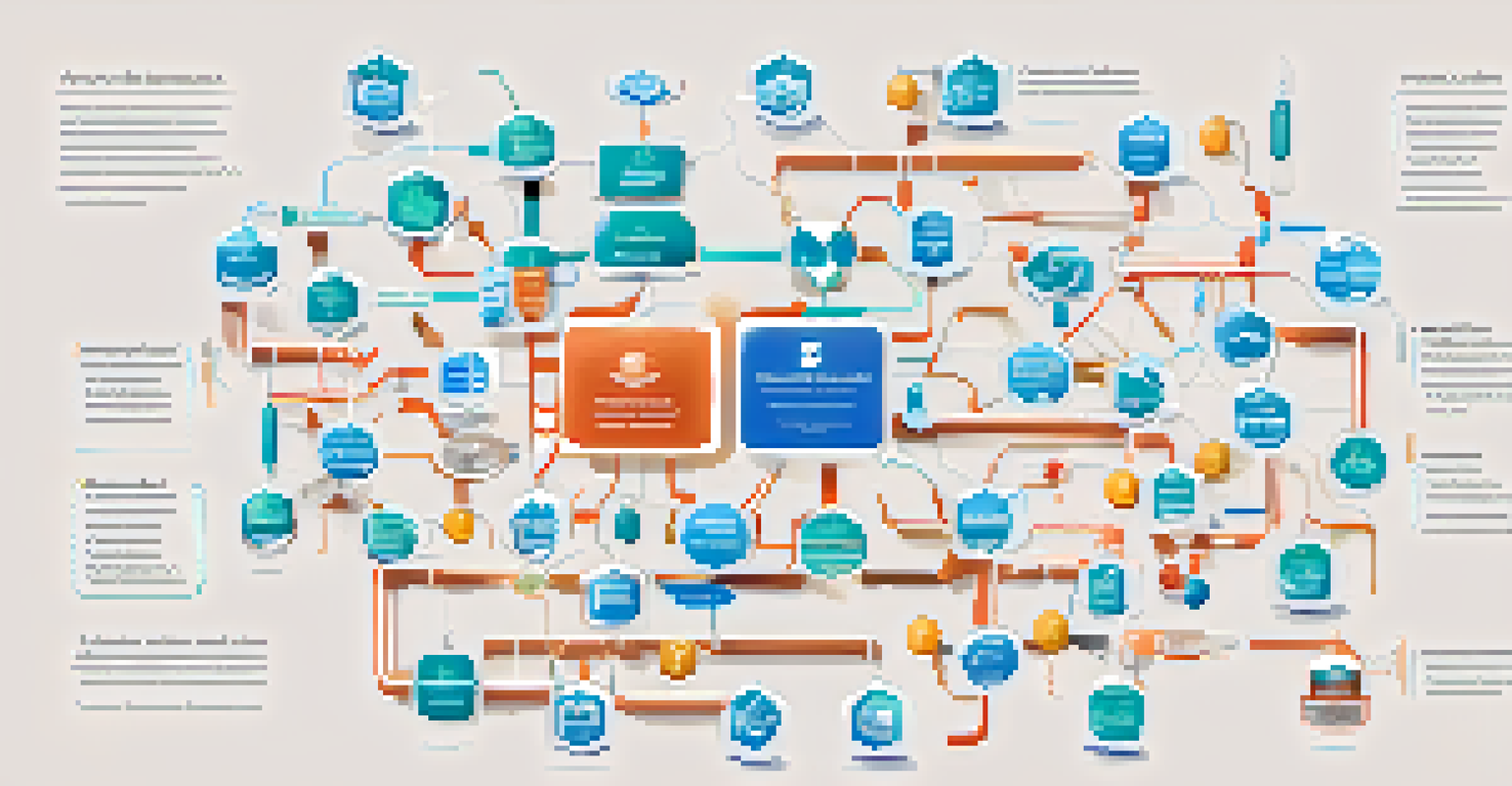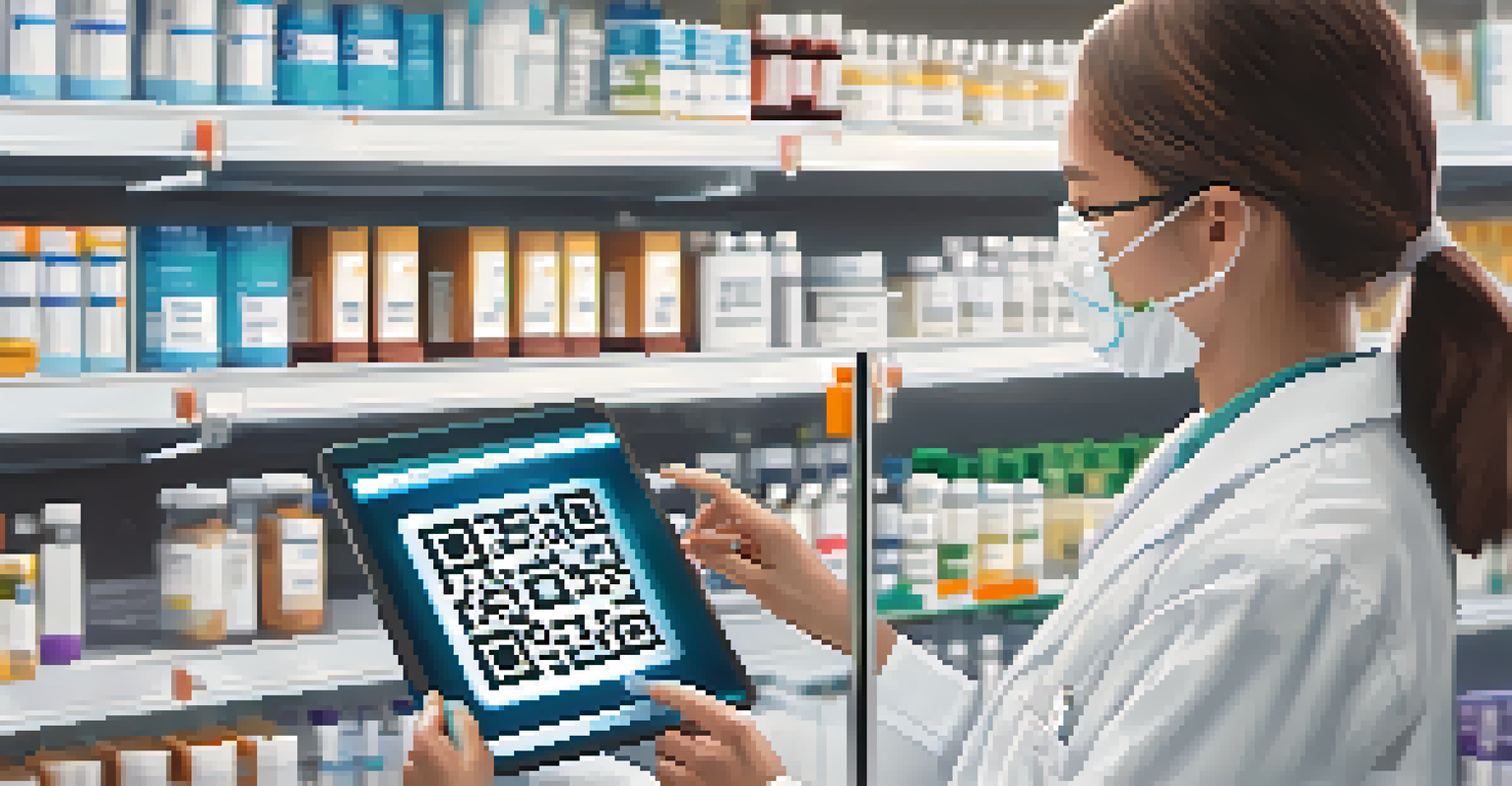The Impact of Blockchain on Drug Supply Chain Transparency

Understanding Blockchain Technology in Simple Terms
Blockchain is essentially a digital ledger that records transactions across multiple computers. This technology ensures that once a piece of data is recorded, it cannot be altered without consensus from the network. Think of it like a shared notebook where everyone can see the notes, but only certain people can make changes, ensuring everyone is on the same page.
The blockchain is the new digital ledger that ensures trust in transactions and data integrity across various sectors.
In the context of the drug supply chain, blockchain can track the journey of a drug from the manufacturer to the pharmacy. This means that every time a drug changes hands, it gets logged into the blockchain, creating a transparent and traceable history. This level of detail is crucial for ensuring the authenticity of pharmaceuticals.
With the rise of counterfeit drugs, using blockchain could help mitigate this issue by providing an indisputable record of a drug's origin. If everyone in the supply chain has access to the same information, it makes it much harder for counterfeit products to slip through unnoticed.
The Challenges of Transparency in the Drug Supply Chain
One of the biggest hurdles in the drug supply chain is the lack of transparency among different stakeholders. From manufacturers to wholesalers to pharmacies, each player has limited visibility into the entire process, making it easy for errors or fraud to occur. For instance, if a pharmacy receives a shipment of drugs without knowing their origin, they’re taking a risk.

Moreover, traditional tracking methods often involve paper records or isolated databases, which can be easily manipulated. This not only creates inefficiencies but also opens the door for counterfeit drugs to enter the system. Imagine trying to piece together a puzzle with missing pieces; that’s how fragmented current systems can be.
Blockchain Ensures Drug Authenticity
By providing a transparent and immutable record of a drug's journey, blockchain significantly reduces the risk of counterfeit products entering the market.
Addressing these challenges requires a shift in mindset and technology. By embracing blockchain, stakeholders can work towards a more integrated system that promotes accountability and trust. This is a crucial step for protecting public health and ensuring that patients receive safe and effective medications.
How Blockchain Enhances Traceability in Drug Distribution
Traceability is the cornerstone of a transparent drug supply chain, allowing stakeholders to track products at every stage of distribution. With blockchain, each transaction involving a drug is recorded in real-time, creating an immutable history. This way, if a problem arises, like a faulty batch of medicine, it’s easy to trace back to the source and take corrective action.
In the future, every drug will be tracked and traced, ensuring safety and authenticity through blockchain technology.
This enhanced traceability can also improve recall processes. Instead of sifting through countless records, companies can quickly identify where potentially harmful drugs are located and inform pharmacies and consumers. It’s like having a GPS for drugs, allowing for swift navigation back to the point of origin.
Furthermore, blockchain technology can provide consumers with information about the drugs they’re purchasing. By scanning a code on the packaging, they could access the entire journey of the drug, from production to delivery. This level of transparency empowers consumers and builds trust in the pharmaceutical industry.
Improving Regulatory Compliance with Blockchain
Regulatory bodies require strict compliance from pharmaceutical companies, which can often feel like navigating a maze. Blockchain simplifies this process by providing a clear and auditable trail of transactions. Each time a drug is produced, handled, or sold, it gets logged, making it easy for regulators to verify compliance without digging through endless paperwork.
In addition, blockchain can help companies meet the stringent requirements set by laws, such as the Drug Supply Chain Security Act (DSCSA) in the U.S. By ensuring that every link in the supply chain is documented, companies can demonstrate compliance without the usual headaches. It’s a bit like having a well-organized filing cabinet that makes finding documents a breeze.
Enhanced Traceability for Safety
Blockchain technology allows stakeholders to trace drugs at every stage of distribution, improving recall processes and ensuring patient safety.
Moreover, with real-time data accessible to both regulators and companies, any discrepancies can be addressed immediately. This proactive approach not only enhances compliance but also contributes to overall safety and efficacy in drug distribution.
Addressing Counterfeit Drugs Through Blockchain Solutions
Counterfeit drugs pose a serious threat to public health, and blockchain offers a powerful solution to this issue. By ensuring that every drug is tracked and verified throughout its journey, blockchain can significantly reduce the chances of counterfeit products entering the market. It acts as a digital fingerprint for each drug, making it much easier to spot fakes.
For instance, if a pharmacy receives a shipment of drugs, they can use blockchain to verify the authenticity of each product before dispensing it to patients. This not only protects consumers but also reinforces the integrity of the pharmaceutical supply chain. Imagine being able to instantly verify the authenticity of your medication with just a scan; that’s the power of blockchain.
Furthermore, by creating a transparent system where all stakeholders have access to the same information, it becomes much harder for counterfeiters to operate. The more people are involved in verifying the legitimacy of drugs, the safer the supply chain becomes.
The Role of Smart Contracts in the Drug Supply Chain
Smart contracts are a fascinating innovation within the blockchain realm, serving as self-executing contracts with the terms directly written into lines of code. In the drug supply chain, smart contracts can automate processes like payments and order fulfillment, reducing the need for intermediaries. This not only speeds up transactions but also minimizes the potential for errors.
For example, once a drug reaches a designated location, a smart contract can automatically trigger payment to the supplier. This seamless interaction ensures that transactions are completed quickly and accurately, creating a more efficient supply chain. It’s akin to having a personal assistant who takes care of all the details without needing constant oversight.
Smart Contracts Streamline Operations
The use of smart contracts in the drug supply chain automates transactions and enforces accountability, resulting in a more efficient system.
Additionally, smart contracts can enhance accountability by ensuring that all parties adhere to agreed-upon terms. If a supplier fails to deliver on time, the smart contract can automatically enforce penalties, fostering a culture of responsibility. This level of automation can revolutionize how the drug supply chain operates.
The Future of Blockchain in Drug Supply Chain Management
As the digital landscape continues to evolve, so too does the potential for blockchain in the drug supply chain. With growing concerns about counterfeit drugs and the need for transparency, many industry leaders are investing in blockchain solutions. The future looks promising, with more companies recognizing the benefits of this technology.
In the coming years, we can expect to see wider adoption of blockchain across the pharmaceutical industry, leading to more streamlined processes and enhanced safety. Just as online banking transformed how we manage finances, blockchain has the potential to radically change how drugs are tracked and verified.

Ultimately, the goal is to create a pharmaceutical ecosystem where patients can trust the medications they receive. By leveraging the power of blockchain, stakeholders can work together towards a more transparent and efficient supply chain, ensuring that safe and effective drugs are always available.